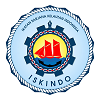PERFORMA UDANG VANAME Litopenaeus vannamei (Boone, 1931) YANG DIPELIHARA PADA SISTEM BIOFLOC DENGAN SUMBER KARBON BERBEDA
Abstract
ABSTRACT
The intensive cultivation of Litopenaeus vannamei with biofloc systems is one of the most efficient way to reduce shrimp cost production, because the biofloc can be used as feed subtitution for L. vannamei cultured. The application of the biofloc system in commercial ponds is still experiencing many obstacles so that it is not optimal in supporting the success of cultivation. One of the factors that determine the success of shrimp farming with a biofloc system is the determination of the right organic carbon source. The objective of this research was to know the effect of addition of C-carbohydrate (wheat, tapioca, and mollases) on shrimp growth, survival rate, biomass, efficency of feed and feed conversion ratio of white shrimp L. vannamei. The design of the research was using a completely randomized design, consisted of three experimental treatments with four replications. The result of this research showed that the biofloc systems with addition of C-carbohydrate on growth performance of the shrimps were not significantly different (P>0.05) among those treatments. The biofloc technology with addition of C-carbohydrate using treatment B (wheat) showed higher survival rate (SR), biomass, feed conversion ratio (FCR), and feed efficiency were significantly different (P<0.05) than the C-carbohydrate from treatment C (tapioca) and D (mollases). The bioflocs system with addition of C-carbohydrate from treatment B (wheat) had SR (75.4±7.2%), biomass (256,8±23,6 g), FCR (1.3±0.1) and efficiency of feed (74.9±7.3%).
Keyword: biofloc, wheat, tapioca, mollase,
ABSTRAK
Budidaya udang vaname (Litopenaeus vannamei) secara intensif menggunakan sistem biofloc merupakan salah satu upaya efisiensi biaya produksi, karena biofloc dapat dimanfaatkan sebagai alternatif pakan bagi udang vaname yang dibudidayakan. Aplikasi sistem biofloc di tambak komersial masih mengalami banyak kendala sehingga tidak optimal dalam mendukung keberhasilan budidaya. Salah satu faktor yang menentukan keberhasian budidaya udang dengan system biofloc adalah penentuan sumber karbon organic yang tepat. Tujuan penelitian ini adalah untuk mempelajari pengaruh penggunaan sumber karbon organik yang berbeda dalam sistem biofloc terhadap pertumbuhan, tingkat kelangsungan hidup, biomassa, efisiensi pemanfaatan pakan, dan konversi pakan udang vaname. Rancangan penelitian yang digunakan adalah rancangan acak lengkap (RAL) terdiri dari 3 perlakuan dengan 4 ulangan. Ketiga perlakukan sumber karbon organik tersebut adalah gandum, tapioka, dan molase. Pemeliharaan udang vaname dilakukan selama 35 hari. Hasil penelitian menunjukan bahwa perlakuan sistem biofloc dengan penambahan sumber karbon organik yang berbeda tidak berpengaruh nyata terhadap pertumbuhan mutlak dan spesifik udang vaname (P>0.05). Penggunaan sumber karbon organik yang berbeda berpengaruh nyata terhadap tingkat kelangsungan hidup, biomasa, konversi pakan, maupun efisiensi pakan udang vaname. Sumber karbon gandum menghasilkan tingkat kelangsungan hidup, biomassa, konversi pakan, dan efesiensi pemanfaatan pakan yang lebih baik dibandingkan dengan sumber karbon tapioka dan molase. Penggunaan sumber karbon gandum dalam sistem biofloc menghasilkan nilai tingkat kelangsungan hidup 75,4±7,2%, biomassa 256,8±23,6g, FCR 1,3±0,1 dan efisiensi pemanfaatan pakan sebesar 74,9±7,3%.
Kata kunci: biofloc, gandum, molase, tapioka
Full Text:
PDF (Bahasa Indonesia)References
Aji, S.B., Sudaryono A., dan Dicky H. (2014).Pengaruh Penambahan Sumber Karbon Organik Berbeda Terhadap Pertumbuhan Dan Rasio Konversi Pakan Benih Lele “(Clarias sp.)” Dalam Media Biofloc. Journal of Aquaculture Management and Technology, 3(4), 199-206.
Almuqaramah, T.M.H., Setiawati M., Priyoutomo N.B., dan Effendi I. (2018). Pendederan Udang Vaname Litopenaeus Vannamei Dengan Teknologi Biofloc Untuk Meningkatkan Pertumbuhan dan Efisiensi Pakan.Jurnal Ilmu dan Teknologi Kelautan Tropis, 10(1), 143-152.
Apriani, I., Setiawati, M., & Budiardi, T. (2016). Produksi yuwana ikan patin Pangasianodon hypophthtalmus (Sauvage 1878) pada sistem budi daya berbasis bioflok dengan penambahan sumber karbon berbeda. Jurnal Iktiologi Indonesia, 16(1), 75-90.
Avnimelech, Y. (2009). Biofloc Technology: A Practical Guide Book. World Aquaculture Society: Louisiana, USA. 120p.
Avnimelech, Y. (2015). Biofloc Technology- A Practical Guide Book, third edition. United States, The World Aquaculture Society. 259 p.
Azim, M. E., & Little, D. C. (2008). The biofloc technology (BFT) in indoor tanks: water quality, biofloc composition, and growth and welfare of Nile tilapia (Oreochromis niloticus). Aquaculture, 283(1-4), 29-35.
Boon, N., Defoirdt T., de Windt W., Van De Wiele T., dan Verstraete W. (2010). Hydroxybutyrate and PolyHydroxybutyrate as Components of Animal Feed or Feed Additives. Patent Application Publication. April: 1-4.
Bossier, P. (2010). Poly-β-hydroxybutyrate (PHB) Increases Growth Performance and Intestinal Bacterial Range-Weighted Richness in Juvenile European Sea Bass. Applied Microbiology and Biotechnology 86 (5): 1535-1541.
Chamberlain, G., Avnimelech, Y., McIntosh, R. P., & Velasco, M. (2001). Advantages of aerated microbial reuse systems with balanced C: N-I: Nutrient transformation and water quality benefits. Global aquaculture advocate, 4(2), 53-56.
Crab, R., Avnimelech, Y., Defoirdt, T., Bossier, P., & Verstraete, W. (2007). Nitrogen removal techniques in aquaculture for a sustainable production. Aquaculture, 270(1-4), 1-14.
Crab, R., Lambert, A., Defoirdt, T., Bossier, P., & Verstraete, W. (2010). The application of bioflocs technology to protect brine shrimp (Artemia franciscana) from pathogenic Vibrio harveyi. Journal of applied microbiology, 109(5), 1643-1649.
Crab, R., Defoirdt, T., Bossier, P., & Verstraete, W. (2012). Biofloc technology in aquaculture: beneficial effects and future challenges. Aquaculture, 356, 351-356.
De Schryver P., Crab, R., Defoirdt, T., Boon, N., dan Verstraete, W. (2008). The Basics of Bioflocs Technology: The Added Value for Aquaculture Aquaculture, 277(34), 125137.
De Schryver, P.D., A. K. Sinha, P. S. Kunwar, S K. Baruah, W. Verstraete, N. Boon, and G. De Boeck. 2010. Hydroxybutyrate (PHB) Increases Growth Performance and Intestinal Bacterial Range-Weighted Richness in Juvenile European Sea
Bass, Dicentrarchus labrax. Applied Microbiology and Biotechnology, 86(5), 1535-1541
Ebeling, J. M., Timmons, M. B., & Bisogni, J. J. (2006). Engineering analysis of the stoichiometry of photoautotrophic, autotrophic, and heterotrophic removal of ammonia–nitrogen in aquaculture systems. Aquaculture, 257(1-4), 346-358.
Effendie, H. (2003). Telaah Kualitas Air: bagi Pengelolaan Sumber Daya dan Lingkungan Perairan. Gramedia. Jakarta.258hal.
Far, H. Z., Saad, C. R. B., Daud, H. M., Harmin, S. A., & Shakibazadeh, S. (2009). Effect of Bacillus subtilis on the growth and survival rate of shrimp (Litopenaeus vannamei). African Journal of Biotechnology, 8(14), 3369-3376.
Gunarto, G., Muliani, M., & Mansyur, A. (2016). Pengaruh Aplikasi Sumber C-Karbohidrat (Tepung Tapioka) Dan Fermentasi Probiotik Pada Budidaya Udang Windu, Penaeus monodon Pola Intensif Di Tambak. Jurnal Riset Akuakultur, 5(3), 393-409.
Hargreaves, J. A. (2013). Biofloc production systems for aquaculture (Vol. 4503, pp. 1-11). Stoneville, MS: Southern Regional Aquaculture Center.
Haslun, J., Correia E., Strychar, K., Morris, T., and Samocha, T. (2012). Characterization of bioflocs in a no water exchange super-intensive system for the production of food size pacific white shrimp Litopenaeus vannamei. International Journal of Aquaculture, 2(6), 29-38.
Hien, N.T.T. (2012). Research and Application of Bioflocs Technology for Intensive Culture White Leg Shrimp Litopenaeus vannamei. Research Institute for Aquaculture, 1(5), 14-16.
Chen, J. C., Liu, P. C., & Lin, Y. T. (1989). Culture of Penaeus monodon in an intensified system in Taiwan. Aquaculture, 77(4), 319-328.
Ogello, E.O., Musa, S.M., Christopher Mulanda Aura C.M., Abwao J.O., dan Munguti J.M. (2014). An Appraisal of the Feasibility of Tilapia Production in Ponds Using BioflocTechnology: A Review. International Journal of Aquatic Science, 5(1), 21-39
Piedrahita, R. H. (2003). Reducing the potential environmental impact of tank aquaculture effluents through intensification and recirculation. Aquaculture, 226(1-4), 35-44.
Reddy, K. R., Feijtel, T. C., & Patrick, W. H. (1986). Effect of soil redox conditions on microbial oxidation of organic matter. In The role of organic matter in modern agriculture (pp. 117-156). Springer, Dordrecht.
Sahu B.C., Adhikari S., dan Dey L. (2012). Carbon, nitrogen and phosphorus budget in shrimp (Penaeus monodon) culture ponds in eastern India. Aquaculture International, 2(1), 3-16.
Suguna, P., Binuramesh, C., Abirami, P., Saranya, V., Poornima, K., Rajeswari, V., & Shenbagarathai, R. (2014). Immunostimulation by poly-β hydroxybutyrate–hydroxyvalerate (PHB–HV) from Bacillus thuringiensis in Oreochromis mossambicus. Fish & shellfish immunology, 36(1), 90-97.
Supono, S., Hutabarat, J., & Prayitno, S. B. (2013). The effect of different C: N and C: P ratio of media on the content of polyhydroxybutyrate in biofloc inoculated with bacterium Bacillus cereus. Journal of coastal development, 16(2), 114-120.
Supono, Hutabarat, J., Prayitno, S. B., Darmanto Y.S. (2014). White Shrimp (Litopenaeus vannamei) Culture using Heterotrophic Aquaculture System on Nursery Phase. International Journal of Waste Resources, 4(2), 1-4.
Supono. (2017). Teknologi Produksi Udang. Plantaxia, Yogyakarta, 168 hal
Ambarsari, L., Artika, I. M., & Susanti, H. E. (2011). Characterization of bioflocculant producing-bacteria isolated from tapioca waste water. HAYATI Journal of Biosciences, 18(4), 193-196.
Takeuchi, T. (1988). Laboratory work chemical evaluation of dietarynutrient In Watanabe T, editor. Fish Nutrition and Marinculture. Tokyo. JICA Kanagawa International Fisheries Training Centre.179-225 p.
Yuniasari, D., & Ekasari, J. (2010). Nursery culture performance of Litopenaeus vannamei with probiotics addition and different C/N Ratio under laboratory condition. Hayati Journal of biosciences, 17(3), 115-119.
DOI: https://doi.org/10.21107/jk.v14i2.9191
Refbacks
- There are currently no refbacks.

This work is licensed under a Creative Commons Attribution 4.0 International License.

Jurnal Kelautan by Program Studi Ilmu Kelautan is licensed under a Creative Commons Attribution 4.0 International License.
Published by: Department of Marine Sciences, Trunojoyo University of Madura













